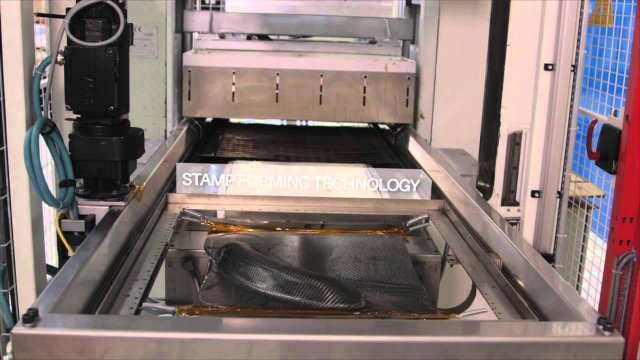Researchers are on the verge of a breakthrough that will allow for the wide-scale use of thermoplastic composites in the automotive industry. These 'futuristic materials' are ultra-light, while being strong and rigid and also sustainable and recyclable. Researchers at the ThermoPlastic Composite Research Center (TPRC) in Enschede (Netherlands) were recently successful in overcoming the last hurdle, which was to design practically faultless components and to make the process for doing so predictable. This makes it possible to determine at an early stage of the design process whether a component can be manufactured at all. This means that the two biggest requirements made by the automotive industry, namely weight reduction and reduced costs, can be satisfied.
"All of the large car manufacturers have a need for thermoplastic composites," says Bert Rietman, business developer at the TPRC and closely involved with the Production Technology chair at the University of Twente. "Products made with these materials can be up to around 40% lighter than the materials usually used in cars and therefore bring great advantages. But many manufacturers are still not keen on these materials. The experience they have gained processing steel, for example, cannot be wholly transferred to composite processing. Manufacturers are often dependent on their suppliers when it comes to innovations and new technologies. Increasingly, it is mainly these suppliers who approach the TPRC, in addition to OEMs (Original Equipment Manufacturers)”.
Understanding the material
In order to come up with the right form and to avoid trial and error as much as possible during the design process, UT doctoral degree candidate Ulrich Sachs carried out research into understanding thermoplastic composites. Only when designers completely understand the way the materials bend, frictionize and slip will it be possible to make completely faultless products. "Designers want to know whether a component can be manufactured or not as quickly as possible," explains Sachs. "For example, they want to know whether the material will wrinkle during forming, and whether the final product and the manufacturing process will be satisfactory. The automotive industry requires simulation of new materials and processes, but the software for forming metal currently in use is not suitable for simulating the behaviour of thermoplastic composites. This means that totally new software is needed in order to allow all of the pieces to fall into place. And we have now designed this software."
About the TPRC
The TPRC is a research centre in the field of pre-competitive research into thermoplastic composites. The TPRC is a world leader in this field and has several partners, including the University of Twente, Boeing, TenCate and Fokker Aerostructures. Various researchers at the University of Twente are involved in the centre's activities. Ulrich Sachs recently obtained his doctoral degree. Doctoral degree candidate Sebastiaan Haanappel had also carried out research into the design process for these lightweight materials at an earlier stage.
Software spin-off Aniform
In order to be able to predict distortions during the press forming process for thermoplastic composites, the TPRC uses AniForm Suite software, developed by AniForm Engineering, a UT spin-off company. The simulation software makes it possible to evaluate whether a product can be manufactured at an early stage in the design process, and also helps to gain a better understanding of the way a particular composite material behaves.
Johnson Controls car seat
At the end of last year, an innovative final product was the result of one of the collaborations that came into being through the TRPC. With the help of the TPRC, multinational company Johnson Controls, which employs 170,000 people and has 1,300 branches, developed a concept for a lightweight car seat. The seat was recently presented at ITHEC (a large international exhibition on thermoplastic composites held in Bremen) for the first time.
What are thermoplastic composites?
In comparison to the processing of thermosetting polymers, the processing of thermoplastic (plastics that become soft when heated) composites (materials made up of different components, often fibre-reinforced plastics) leads to much faster manufacturing speeds. A disadvantage was that the manufacturing process was not always problem-free. However, the findings of UT doctoral degree candidate Ulrich Sachs and Sebastiaan Haanappel, who obtained his doctoral degree at an earlier date, mean that this risk is now largely a thing of the past.






